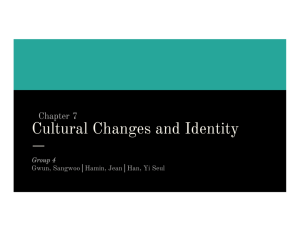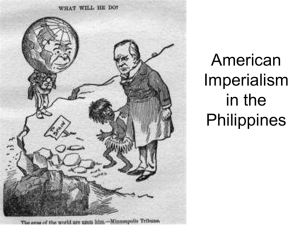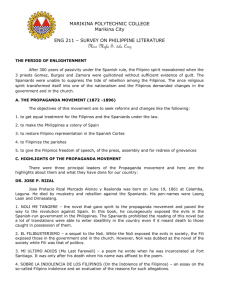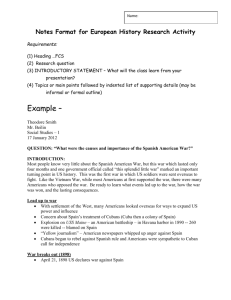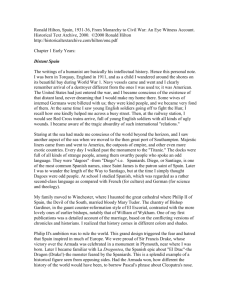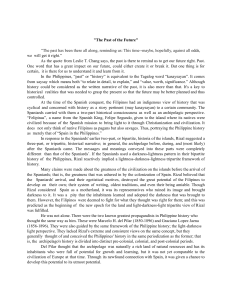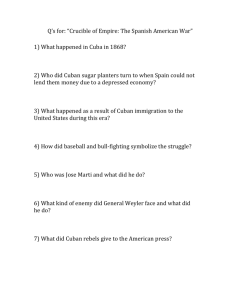File
advertisement
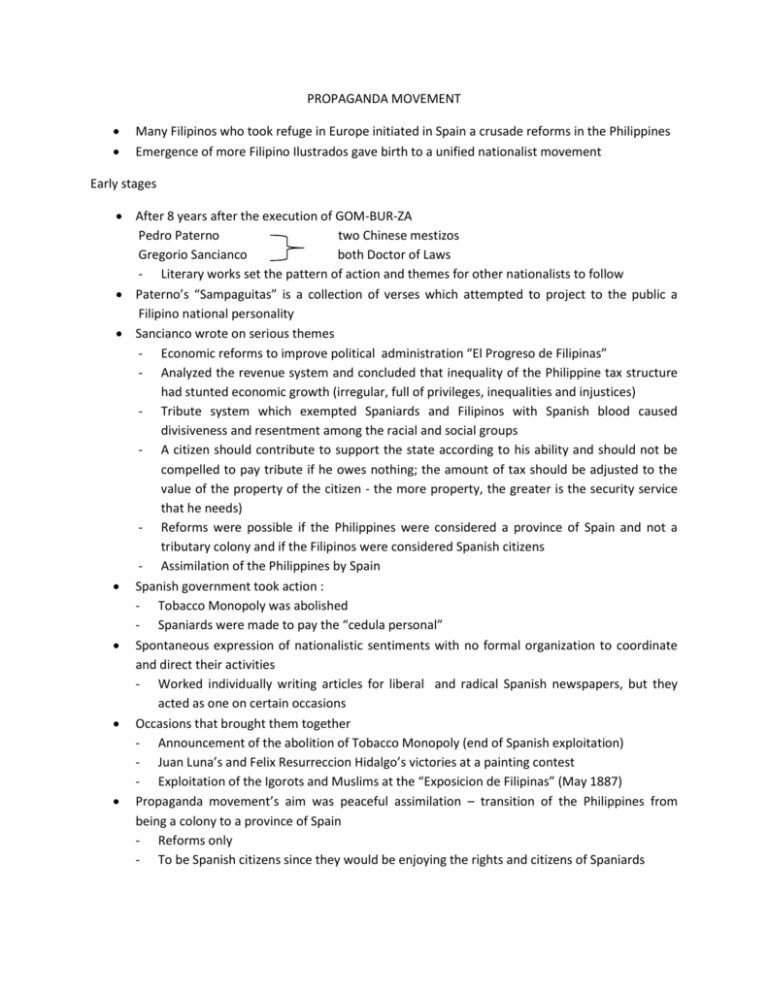
PROPAGANDA MOVEMENT Many Filipinos who took refuge in Europe initiated in Spain a crusade reforms in the Philippines Emergence of more Filipino Ilustrados gave birth to a unified nationalist movement Early stages After 8 years after the execution of GOM-BUR-ZA Pedro Paterno two Chinese mestizos Gregorio Sancianco both Doctor of Laws - Literary works set the pattern of action and themes for other nationalists to follow Paterno’s “Sampaguitas” is a collection of verses which attempted to project to the public a Filipino national personality Sancianco wrote on serious themes - Economic reforms to improve political administration “El Progreso de Filipinas” - Analyzed the revenue system and concluded that inequality of the Philippine tax structure had stunted economic growth (irregular, full of privileges, inequalities and injustices) - Tribute system which exempted Spaniards and Filipinos with Spanish blood caused divisiveness and resentment among the racial and social groups - A citizen should contribute to support the state according to his ability and should not be compelled to pay tribute if he owes nothing; the amount of tax should be adjusted to the value of the property of the citizen - the more property, the greater is the security service that he needs) - Reforms were possible if the Philippines were considered a province of Spain and not a tributary colony and if the Filipinos were considered Spanish citizens - Assimilation of the Philippines by Spain Spanish government took action : - Tobacco Monopoly was abolished - Spaniards were made to pay the “cedula personal” Spontaneous expression of nationalistic sentiments with no formal organization to coordinate and direct their activities - Worked individually writing articles for liberal and radical Spanish newspapers, but they acted as one on certain occasions Occasions that brought them together - Announcement of the abolition of Tobacco Monopoly (end of Spanish exploitation) - Juan Luna’s and Felix Resurreccion Hidalgo’s victories at a painting contest - Exploitation of the Igorots and Muslims at the “Exposicion de Filipinas” (May 1887) Propaganda movement’s aim was peaceful assimilation – transition of the Philippines from being a colony to a province of Spain - Reforms only - To be Spanish citizens since they would be enjoying the rights and citizens of Spaniards - Reforms : Equality of the Filipinos and Spaniards before the laws Restoration of Philippine representation in the Spanish Cortes Secularization of Philippine parishes and expulsion of the friars Human rights (freedom of speech, press and to meet and petition for grievances) Members of the Propaganda Movement (not all wealthy Filipinos but they were scions of good families) Filipino exiles of 1872 Patriots who left the islands to escape persecution and arrest Those who had been to Spain - Marcelo H. Del Pilar, a lawyer and journalist from Bulacan Toribio, Marcelo’s brother was implicated in the Cavite Mutiny and exiled Marcelo joined in “dupluhan and “dalitan” (literary jousts during fiestas) Spoke and satirized corrupt Spanish officials and friars “Dasalan at Tocsohan” (Prayers and Mockeries) Parodied the Lord’s prayer, Hail Mary and the Apostles’ creed (anti-clerical protests) Created the “Junta de Propaganda” House was burned mysteriously suspected of being the master mind of secret meetings held in various towns; being the author of libelous and slanderous essays; popularizing the “Noli”; being against the church and government (ordered arrested but escaped to Spain) - Graciano Lopez Jaena parodied religious literature in his satires saw miser of the rural communities and the abuses done by the Spaniards in Iloilo “Fray Botod” or Friar Pot belly (Fray Botod was thin and hungry as a mosquito but soon became stout because of taking the food of people) Because of his anti-clerical literature, he moved to Spain - Jose P. Rizal, belonged to a well-to-do family in Calamba, Laguna In 1882, went to Spain to study medicine at the Universidad Central de Madrid Gained prestige from the “Noli Me Tangere” (reflected the defects of Spanish rule in the Philippines particularly abuses of the friars; forbidden for its intensity) May have been the first Filipino political cartoonist Most scholarly among the group Annotated the “Sucessos de las Islas Filipinas” to inspire countrymen, to evoke pride in our ancestry and the antiquity and gentility of Filipino culture (the Sucessos became a good source of refuting prejudicial comments of the Spaniards) - - Other great Filipino propagandists : Antonio Luna, Pedro Serrano Laktaw, Isabelo de los Reyes, Juan Luna and Felix Resurrection Hidalgo Supported by a number of Spanish friends like Juan Atayde and Miguel Morayta (Rizal’s professor at the University) “Circulo Hispano-Filipino” and “Associacion Hispano-Filipino” – were the first two propaganda organizations founded with members who are mostly Spaniards; too moderate in clamoring for reforms “La Solidaridad” is the first purely Filipino organization founded in Barcelona Equality so that the rights and dignity of the Filipinos would be granted and respected through reforms “La Solidaridad” is also the name of the org.’s newspaper which was published every two days To spread and defend ideals of democracy To work for and promote progress in politics, science, arts and letters, commerce, agriculture and industry Editorials, news stories, articles and speeches of Spaniards supporting the org. were contained in the newspaper They expose, criticize, satirize intolerable conditions in the Philippines caused by inefficient and corrupt Spanish administration; they also made counter-attacks in the Solidaridad against antiFilipino writers Many Filipino propagandists turned masons like Rizal and Del Pilar because the needed the help of the masons in Spain and other countries for their fight for reforms Freemasonry were fraternal lodges turned into social societies opened to non-masons First Masonic lodge was already here in Manila in 1856, but did not allow Filipinos only Spaniards Filipino expatriates, students and intellectuals became Freemasons in Spain because they got attracted to the freemason’s ideals of equality, religious tolerance, fraternity and liberty Problems of the Propagandists Inadequate financial resources (a few sympathizers gave money and Spanish government deported propaganda movement supporters) Differences of opinions (rivalries and criticism of one another because no substantial reform was granted) Personal problems (homesickness and concern for their families left in the Philippines) Death of Del Pilar and Jaena (died of Tuberculosis) Rizal’s La Liga Filipina was a mutual aid and self-help society which dispenses scholarship funds and legal aid, loans capital and sets up cooperatives OBJECTIVES : 1) Unification of the whole archipelago into one compact, vigorous and homogenous body 2) Protection in cases of want and necessity 3) Defense against violence and injustice 4) Encouragement of instruction, agriculture and commerce 5) Study and implementation of reforms Rizal’s pamphlets distributed by the La Liga caused his deportation to Dapitan

